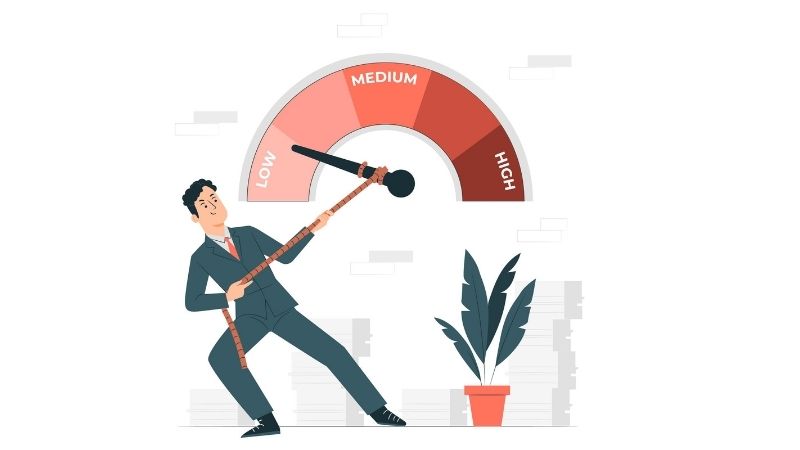Do you carry out trading transactions in the field of cryptocurrency, but do you believe you can’t maximize your potential in trading because of the lack of capital? Thankfully, that is the purpose of leveraged trading, which is offers more than just trading. Leveraged transactions, which provide this opportunity to investors, also bring with them some risks. In this article, we will discuss and elaborate the question of ‘What is leveraged trading?’ from different perspectives and provide detailed information on the subject. We will start with examining types of transactions under the title of ‘What Does Leveraged Transaction Mean.’
What is Leveraged Trading in Crypto?
Leveraged trading in crypto is a type of transaction that allows investors to open larger positions even though they have a small amount of capital. This method, which is also used in other financial markets, allows investors to increase their profits by taking larger positions with increased risk and taking advantage of opportunities in the markets.
Furthermore, one of the opportunities offered by leveraged trading in crypto is that you can benefit from crypto currencies not only when the market is rising but also when it is falling. This provides investors with the flexibility to seize the opportunity to make profits even when prices are falling.

How Does Leveraged Trading Work?
It can be seen as investors can take larger positions with a small amount of capital. The basis for this is that, the investor controls an amount above his own capital by using a leverage ratio . In leveraged transactions, investors can generally deposit collateral and open a position up to a certain multiple of this collateral.
One of the advantages of leveraged trading is the possibility of increasing your potential profit. Even a small price change can turn into a big profit. However, in this case the risk also increases. Because in leveraged transactions, both the profit and loss amount may exceed the invested capital. Therefore, risk management is very important in leveraged transactions. Therefore, it should be used carefully and consciously.
Leveraged Trading Examples
For example, if you trade with 10x leverage, you can open a position that’s 10 times the size of your investment. However, this also means that both the potential profit and loss are increased. If the position moves in the right direction, the investor makes a profit. On the other hand, if the position moves against expectations, the investor will be faced with in a loss. Since the position is opened with 10x leverage, both profit and loss will be incresed by 10 times. Of course, leverage can be applied at different rates, but regardless of the ratio, the principle of leveraged trading works the same way.

How to Calculate Leverage?
Leverage is the ratio used to control the size of the position opened by the investor and is usually expressed as a numerical value. Leverage ratio indicates how much position the investor can open on the capital he has.
The leverage ratio is determined by the collateral amount. The following formula can be used for leveraged trading calculation:
Leverage Ratio = Position Size/Collateral Amount
For example, if an investor deposited $1,000 in collateral to open a $ 10,000 position, the leveraged trading calculation would work as follows:
Leverage Ratio = 10,000/1000 = 10
In this case, the investor’s leverage ratio is 10x . In other words, the investor opens a position 10 times the size of his own capital.
The leverage ratio may vary depending on the investor’s collateral. Investors can take larger positions by using more leverage. Of course, it is important to remember that this situation may increase the potential of the profit or loss ratio.
What is the Risk of Leverage? Is Leveraged Trading Reliable?

Leverage risk refers to the increased potential loss in leveraged transactions. It can be influenced by various factors, such as excessive leverage, market movements, and unexpected price fluctuations. Because of this, investors should take precautions when making leveraged transactions, such as setting stop-loss orders and carefully selecting their leverage levels to manage risk. Additionally, using high leverage without enough knowledge or experience should be avoided.
What are the Advantages of Leveraged Trading in Crypto?
Leveraged trading in crypto can offer investors a number of advantages, which are listed below:
- Opportunity to Open Larger Positions: Leveraged transactions enable investors to open larger positions above their own capital. This increases potential profits.
- High Liquidity: Cryptocurrency markets generally have high liquidity. This allows investors who want to trade with leverage to trade large amounts and quickly open and close their positions.
- Opportunity to Take Short Positions: Leveraged transactions provide investors with the opportunity to take short positions with the expectation that the value of cryptocurrencies will decrease. In this way, investors can also make profits from falling markets.
- Various Leverage Levels: Cryptocurrency exchanges often offer different leverage levels. This allows investors to choose the appropriate leverage ratio based on their risk preferences and strategies.
- Hedging Opportunity: Cryptocurrency investors can open reverse positions to hedge or protect their existing positions using leveraged transactions. This provides protection against uncertainties in the markets.
Of course, it should not be forgotten that these advantages may result in losses if expectations do not go as desired.
What is the Difference Between Leveraged Trading and Spot Trading?
The difference between leveraged transactions and spot transactions specifically for cryptocurrencies can be examined comparatively in the table below.
| FEATURES | LEVERAGED TRADING | SPOT TRADING |
| Process type | Leveraged transactions allow the investor to open larger positions with a small collateral. | Spot transactions allow the investor to buy or sell cryptocurrency as real assets. |
| Profit and Loss Potential | Investors can make larger profits or losses by using leverage. | Profit and loss are directly affected by the change in the price of the investor’s cryptocurrency. |
| Leverage Ratios | Different leverage levels are usually offered, such as 2x, 5x, 10x. | Leverage is not used, investors’ positions are opened with full capital. |
| Collateral Requirement | The collateral amount is lower in leveraged transactions. | In spot transactions, there is a collateral requirement of full value. |
| Position Duration | In leveraged transactions, the maturity of positions can often be short. | In spot transactions, investors can keep their positions open for as long as they want. |
| Risk Level | Leveraged transactions involve high risk. | Spot transactions involve risk as much as the capital invested by the investor. |
Leveraged transactions offer higher risk and profit potential, while spot transactions represent a more traditional, lower-risk approach. Investors can choose between these two types of transactions based on the strategy they plan to implement and the level of risk they are willing to take during these transactions.
What is Leveraged Token?
Leveraged tokens are digital assets that are often traded on cryptocurrency exchanges to mimic leveraged financial products . These tokens offer cryptocurrency investors leveraged trading opportunities which are not available in spot markets.
Leveraged tokens generally track the performance of a particular crypto asset and react to changes in the price of that asset with a certain leverage ratio. For example, a leveraged token that tracks the price of Bitcoin and offers 3x leverage, if the price of BTC increases by 1%, the token price can increase by 3%. But equally, if the Bitcoin price drops 1%, the token price could drop 3%.
For example, BTDOWN or BTCUP are considered leveraged tokens. These tokens offer leverage at rates varying up to 4%. Of course, while these tokens offer investors the opportunity to trade with leverage in cryptocurrency markets, they also carry higher risks than spot markets.
Where are Leveraged Transactions Made?
As can be expected, leveraged transactions in cryptocurrencies are made through cryptocurrency exchanges . Which is offered by both centralized and decentralized (DEX) cryptocurrency exchanges.
When deciding on which platform to trade on ; It is important to consider factors such as reliability, liquidity, leverage ratios, trading fees and whether the platform is user-friendly . It may also be useful to examine the variety of assets and trading features each platform offers.
How to Transact Coins with Leverage?
the most important question that comes into the minds is to how to perform a leveraged transactions.
The usual steps to make leveraged transactions with coins are as follows:
- Choose an Exchange: Determine the cryptocurrency exchange where the leveraged transaction will be made.
- Create an Account and Verify: Create an account at the cryptocurrency exchange of your choice and complete the identity verification process. Authentication is a necessary security process to ensure exchanges’ security standards.
- Deposit Collateral: Deposit cryptocurrency or fiat currency into your account as collateral to get ready to start leveraged trading.
- Visit the Leveraged Trading Section: Make your selection by going to the leveraged trading section of the exchange and deciding on the crypto asset you want to trade.
- Decide on Leverage Ratio and Position Size: Determine the crypto asset you want to trade and the leverage ratio. The leverage ratio determines the multiples of collateral used to make transactions.
- Open a Position: Open a buying or selling position with the leverage ratio you have determined. When you perform this operation, your position will be opened with the leverage rate you have determined.
- Enter Stop-Loss and Take-Profit Orders: Set stop-loss and take-profit orders to manage possible risks. A stop-loss order helps limit the loss, while a take-profit order helps you set a specific profit target.
- End Position: When you want to close your position, give the necessary instructions to close your position on the same trading platform.
When trading with leverage, it is important to carefully manage risks and constantly monitor market movements. Also, always keep in mind that, leveraged transactions involve high risk and also carries the risk of losing the entire invested capital. Therefore, if a leveraged transaction is to be made, it would be very useful to first make a good market analysis and use adequate risk management strategies.
